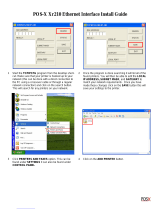
GL-35DSR Table of Contents
Table of Contents
1 Getting Started ........................................................................................................................................ 1
1.1 About this Device ............................................................................................................................... 1
1.2 Package Contents ............................................................................................................................. 1
1.3 System Requirements ....................................................................................................................... 1
1.3.1 Supported Operating Systems .................................................................................................................. 1
1.3.2 Supported USB Devices ........................................................................................................................... 1
1.4 Detailed View ..................................................................................................................................... 2
1.4.1 Front ......................................................................................................................................................... 2
1.4.2 Rear .......................................................................................................................................................... 3
1.5 Quick Installation Guide ..................................................................................................................... 4
1.5.1 Power ON / OFF Procedure ...................................................................................................................... 4
1.6 About Data Backup ............................................................................................................................ 4
1.7 Before Use ......................................................................................................................................... 5
1.7.1 Hard Drive Assembly ................................................................................................................................ 5
1.7.2 Initializing the NAS System ....................................................................................................................... 6
2 NAS Settings and User Interface ........................................................................................................... 9
2.1 How to login ....................................................................................................................................... 9
2.1.1 Discover Tool ............................................................................................................................................ 9
2.1.2 Web Browser & Device Name on a PC ................................................................................................... 10
2.1.3 Safari Web Browser & Bonjour Bookmarks on a Mac ............................................................................. 10
2.2 User Interface & Settings ................................................................................................................. 11
2.2.1 Albums .................................................................................................................................................... 11
2.2.2 Library ..................................................................................................................................................... 12
2.2.3 Preference .............................................................................................................................................. 13
2.2.4 Applications ............................................................................................................................................. 18
2.2.5 Registration ............................................................................................................................................. 20
2.2.6 About ...................................................................................................................................................... 20
3 Network Storage & Extra Features ...................................................................................................... 21
3.1 File Access on a PC ........................................................................................................................ 21
3.1.1 Windows Explorer ................................................................................................................................... 21
3.1.2 Mapping a Network Drive ........................................................................................................................ 21
3.1.3 Disconnecting a Network Drive ............................................................................................................... 22
3.1.4 FTP ......................................................................................................................................................... 23
3.2 File Access on a Mac ....................................................................................................................... 24
3.2.1 SMB ........................................................................................................................................................ 24
3.2.2 FTP ......................................................................................................................................................... 25
3.3 BitTorrent Download Manager ......................................................................................................... 26
3.3.1 Starting a Download ................................................................................................................................ 26
3.4 Printer Server ................................................................................................................................... 27
3.4.1 Installation on a PC ................................................................................................................................. 27
3.4.2 Installation on a Mac ............................................................................................................................... 30
3.5 Media Server ................................................................................................................................... 31
3.5.1 Xbox 360 ................................................................................................................................................. 31
3.5.2 PlayStation 3 ........................................................................................................................................... 32
3.6 iTunes Server .................................................................................................................................. 33
3.7 USB Copy ........................................................................................................................................ 34
4 Appendix ................................................................................................................................................ 35
4.1 Specifications ................................................................................................................................... 35
4.2 Trademarks ...................................................................................................................................... 35
4.3 Technical Terms .............................................................................................................................. 36
4.4 FAQ .................................................................................................................................................. 36
4.5 Precautions ...................................................................................................................................... 37
4.5.1 Power on/off precautions ........................................................................................................................ 37
4.5.2 Location and placing precautions ............................................................................................................ 37
4.5.3 Electricity and power plug ....................................................................................................................... 37
4.5.4 Cables ..................................................................................................................................................... 37
4.6 Important Notices ............................................................................................................................. 37
4.6.1 About this Manual ................................................................................................................................... 37
4.6.2 Intellectual Property ................................................................................................................................ 37





















